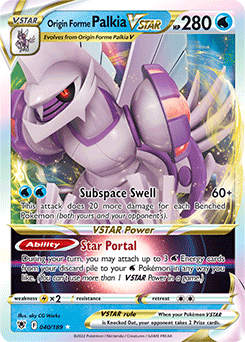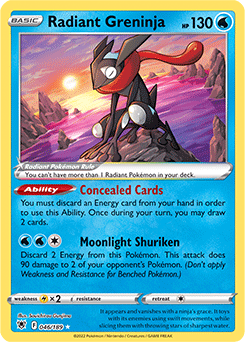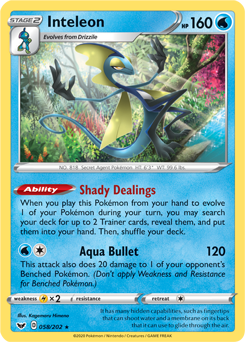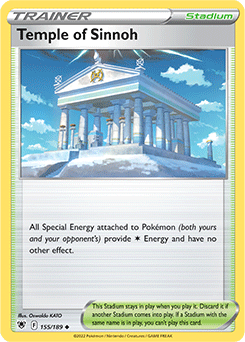The Pokémon Company recently released one of the latest official expansions as part of the Pokémon Trading Card Game (TCG). Read on below to learn more:
Find out why the Spatial Pokémon is blasting off in competitions around the world.
By Tord Reklev, Contributing Writer
The new Pokémon TCG: Sword & Shield—Astral Radiance expansion has already made a real splash in the realm of the Pokémon Trading Card Game metagame thanks to a few powerful Water-type Pokémon. Origin Forme Palkia VSTAR in particular has quickly proven to be one of the new cards to beat. At the Regional Championships in Melbourne, Australia—the first Regional Championships in which the set was legal—Origin Forme Palkia VSTAR made up the entirety of the Top 8. Variants of the deck surfaced throughout the tournament, showing that there is more than one way to harness this Legendary Pokémon’s power.
One thing that all these decks had in common was the pairing of Palkia with the new Radiant Greninja. The synergy between these two cards is nothing short of amazing. Let’s dive in and explore how and why!
Looking at Origin Forme Palkia VSTAR, the first thing that I noticed is how similar its Subspace Swell attack is to the attacks of the Legendary Beasts Suicune V, Raikou V, and Entei V. The difference in base damage is significant—Subspace Swell starts at 60 damage (instead of 20) and adds 20 damage for every Benched Pokémon in the game. If both players have five Benched Pokémon, the attack will do an impressive 260 damage. Add Choice Belt and Inteleon‘s Quick Shooting Ability to the mix, and you will see how the damage can add up quickly and threaten a Knock Out on just about any Pokémon. This attack requires only 2 Water Energy, making it one of the most cost-effective attacks in the game.
Origin Forme Palkia VSTAR’s Star Portal Ability is also impressive—it can attach 3 Water Energy cards from the discard pile to any of the player’s Water-type Pokémon in play. Energy acceleration has historically been one of the strongest effects in the game, and this time is no exception.
With Sword & Shield—Astral Radiance, a new kind of Pokémon card was introduced: Radiant Pokémon. Like Pokémon Star from the EX era, you can only include one of these powerful Shiny Pokémon in your deck. Even with players being limited to a single Radiant Pokémon, these cards will have a big impact on how games are played out. Radiant Greninja seems to be the perfect fit for Origin Forme Palkia VSTAR, as its Concealed Cards Ability synergizes beautifully with Origin Forme Palkia VSTAR’s own Star Portal Ability. Moving Energy cards to the discard pile while simultaneously drawing cards is good on its own, but being able to attach the discarded Energy back into play with Origin Forme Palkia VSTAR makes it even better.
In addition to its strong Ability, Radiant Greninja’s Moonlight Shuriken attack should not be underestimated. For a long time, Rapid Strike Urshifu VMAX‘s G-Max Rapid Flow attack has arguably been one of the best in the game: it can target two of the opponent’s Pokémon for 120 damage. The damage that Radiant Greninja’s attack does is slightly less, but it’s still enough to take down popular support Pokémon in a similar fashion. Sobble and Drizzile, among others, will be prime targets for this attack. And thanks to Origin Forme Palkia VSTAR’s Star Portal Ability, Radiant Greninja can potentially attack as early as the second turn of the game. This puts a lot of pressure onto the opponent and can start swinging the Prize card tally into the Water deck’s favor.
Now that we have looked at the stars of the deck, it’s time to explore my current favorite way of playing with these powerful Water-type Pokémon cards:
Our example deck list features a solid line of Origin Forme Palkia VSTAR, as it will be our main attacker. Another new card from the Sword & Shield—Astral Radiance expansion is Starmie V; its Energy Spiral attack is excellent for punishing the opposing player for attaching Energy cards into play. This attack offers an especially effective defense against Arceus VSTAR and its Trinity Nova attack—it forces the opponent to think twice about putting additional Energy into play. Starmie V is also one of the few Basic Pokémon that has no Retreat Cost, making it a great opening Pokémon. Retreating into a Sobble on the first turn of the game with Starmie V can turn a mediocre start into an excellent one.
Manaphy is mainly here for its Wave Veil Ability. As previously mentioned, Radiant Greninja is extremely effective at targeting opposing Sobble and Drizzile, which gives Manaphy a very important role in protecting the precious Inteleon engine.
As you can see, we have chosen to pair Origin Forme Palkia VSTAR with the now well-established Inteleon engine. There are several strong arguments for this. Committing an Energy card for use with Sobble’s Keep Calling attack on the first turn of the game will not be a problem for this deck, as Origin Forme Palkia VSTAR’s Star Portal Ability can accelerate enough Energy into play on the second turn of the game regardless. Filling up the Bench with Sobble will allow Origin Forme Palkia VSTAR to do more damage, and simultaneously set up for a stream of Shady Dealings Abilities from Drizzile and Inteleon. Utilizing the Inteleon engine also allows for a sea of tricks in the Trainer lineup, making the deck flexible going into different matchups. The Inteleon with the Quick Shooting Ability can also come in handy as it gives the deck even more reach.
Finally, a Lumineon V has been added to the list. Lumineon V really shines during the first turn of the game, as its Luminous Sign Ability enables Quick Ball and Ultra Ball to be used as additional ways of finding Irida. Having a low-HP Pokémon V in play can often be a liability, but keep in mind that Inteleon V can also be fueled by Star Portal in a pinch, allowing Lumineon V to swiftly escape back into the deck with its Aqua Return attack.
One of my favorite cards from Sword & Shield—Astral Radiance is the new Supporter card Irida. This card will be a great fit for any deck featuring the Inteleon engine, but it’s especially good in this one since every Pokémon is a Water type. Picking up a Shady Dealings Drizzile or Inteleon and an Item card will indirectly give access to any two cards in the deck, making it one of the best and safest ways to set up a strong field. Irida is also the reason why this list includes only one Battle VIP Pass—you will have plenty of ways to search it out with Irida. Remember that Lumineon V can search out Irida, which means a Quick Ball or an Ultra Ball can eventually turn into a Battle VIP Pass. Irida’s flexibility makes it worthy of filling four spots in our deck.
It shouldn’t be surprising to see Boss’s Orders in here either, as targeting your opponent’s Benched Pokémon will forever be one of the strongest effects in the game.
With the help of the Inteleon engine and the Shady Dealings Ability, this deck can afford to run a lot of single copies of Trainer cards. As you can see, this deck plays four single copies of Supporter cards that all have their unique uses. For instance, both Raihan and Melony can help accelerate Energy into play after the VSTAR Power is used. While Raihan can be used only after the opponent has taken a Knock Out, it’s not limited to Pokémon V, meaning you could potentially pull off another big attack with Radiant Greninja should the opponent choose to target other Pokémon instead. Using Raihan to fuel Inteleon’s Aqua Bullet attack will also be an attractive option. Melony can be played at any point and can help accelerate Energy onto Origin Forme Palkia V or VSTAR, Lumineon V, and Starmie V. One Pal Pad ensures that the deck can reuse any of the Supporter cards an additional time, too.
For recovery, this deck uses Nessa. Since every Pokémon and Energy is Water type, Nessa becomes truly powerful. Streaming attackers and Energy attachments for the next few turns after a Nessa will be a breeze, and recycling Energy cards is also great for additional uses of the Concealed Cards Ability.
Finally, the card I have been the most excited about from Sword & Shield—Astral Radiance: Roxanne. Until now, Marnie has been the strongest hand disruption card available in the format. Leaving the opponent at four cards before their turn is usually not enough to prevent them from doing what they want, but being able to set the opponent down to only two cards, on the other hand, changes things drastically and makes for a much better comeback card. With the inclusion of Roxanne, the deck will be able to punish weakly developed board states and potentially turn an unfavorable game around.
The Pokémon search lineup is mostly what you would expect from a deck featuring the Inteleon engine, but with another new addition from Sword & Shield—Astral Radiance. Hisuian Heavy Ball has a unique effect, letting the player search their Prize cards for a Basic Pokémon to swap out with the Hisuian Heavy Ball. Playing this card will make sure that prizing one of those crucial Basic Pokémon is much less likely to happen. Radiant Greninja will for sure be the most important one, but having insurance against awkward Prizes in general is a welcome addition.
Scoop Up Net‘s main purpose in this deck is to reset some of the Abilities, enabling them to be used multiple times in the same turn. In the early rounds, using multiple Concealed Cards Abilities can help fuel Star Portal even faster while simultaneously drawing a lot of cards. Later, Scoop Up Net can be used to pick Inteleon back up for additional uses of Shady Dealings and Quick Shooting.
Yet another new card from Sword & Shield—Astral Radiance is our deck’s Stadium card, Temple of Sinnoh. This card will make all Special Energy cards in play lose their effects and provide only a single Colorless energy. Many great Energy cards like Rapid Strike Energy, Single Strike Energy, and Fusion Strike Energy will lose their potency. Saving this Stadium card until the later stages of the game to be paired with a Roxanne can be especially impactful against certain matchups.
For Pokémon Tool cards, we have Choice Belt and Tool Jammer. The Choice Band will provide some extra reach against Pokémon V, while the Tool Jammer works as a defensive option against opposing Choice Belt and even Supereffective Glasses. With the raising popularity of Big Charm, Tool Jammer can also be used offensively.
Right now, Water decks are spoiled by their way of searching out Energy, Capacious Bucket. While every other type of Basic Energy must use the Energy Search Item card to grab a single Energy card, Capacious Bucket can search out a pair of Water Energy. Irida and Shady Dealings both give easy access to the Capacious Bucket and ensure that the deck has both hand attachments and fuel for the Concealed Cards Ability.
We mentioned earlier that what makes this deck so strong is the combination of Origin Forme Palkia VSTAR and Radiant Greninja. Their Abilities have great synergy, but their attacks are also a perfect fit. Radiant Greninja will tempt the opposing player to play down Manaphy to protect their Benched Pokémon, but that will play straight into the Subspace Swell attack from Origin Forme Palkia VSTAR. This sort of double pressure makes it a very difficult deck to go up against, and players might have to choose between playing around Moonlight Shuriken or Subspace Swell.
A common trick in the Pokémon Trading Card Game is forcing your opponent to take more Prize cards than necessary to gain an advantage. This deck does that naturally, as it typically wants to attack with Radiant Greninja once. This will give up a single Prize card, opening the way for a stream of Origin Forme Palkia VSTAR afterwards. At the end of the game, your opponent will then be forced to either find a way around the Active Origin Forme Palkia VSTAR or perhaps spend an additional attack for the Knock Out.
Water-type Pokémon make up a lot of the strong cards in the new Sword & Shield—Astral Radiance expansion, and this deck flows in perfect harmony. Irida combined with the Inteleon engine enables a safe route for setting up your board and is a ton of fun to play, too. You should strongly consider trying this deck out for yourself if you haven’t already!
Look for more Pokémon TCG strategy and analysis at Pokemon.com/Strategy.
About the Writer

Tord Reklev
Tord Reklev is a contributing writer for Pokemon.com. He is a longtime player from Norway, playing the game since he was 6 years old. He is notable for being the only Masters Division player to win the North America, Europe, and Oceania Internationals, and he recently made Top 4 at the World Championships. Outside of the game, he is a student and enjoys playing tennis. You can find him at most big events and can follow him on Twitter at @TordReklev.
Source: Pokemon.com
Source:Pokémon










